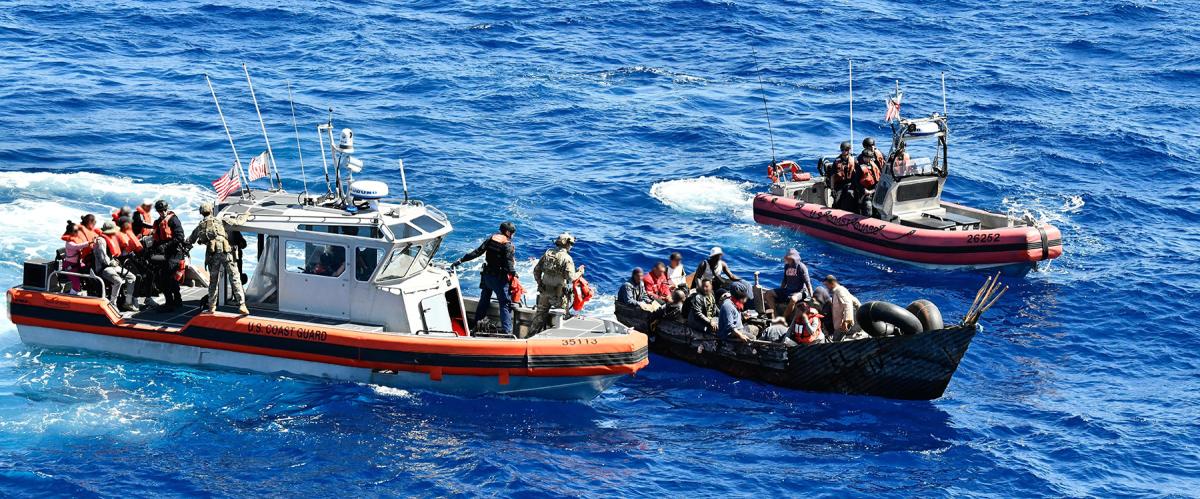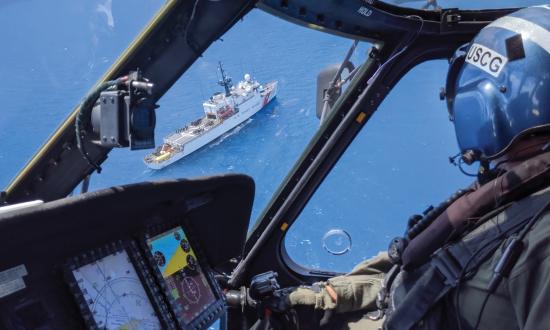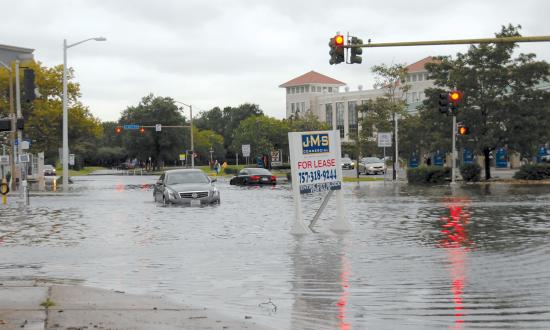Coast Guard migrant interdiction operations have reached a breaking point across the southeastern U.S. maritime border and the Caribbean Sea. Major economic and social turmoil unfolding in Caribbean countries, particularly Haiti and Cuba, are causing maritime migration to reach increasingly high levels and are pushing the Coast Guard’s interdiction resources—and its people—far beyond sustainable or acceptable levels. Without intervention, both this mission and Coast Guard men and women are at risk.
Authority at Sea
The Coast Guard is the primary agency responsible for enforcing U.S. immigration laws at sea and securing the maritime border. This authority is vested in Title 14 USC 89 and Title 14 USC 2, which authorizes the Coast Guard to make inquiries, examinations, inspections, searches, seizures, and arrests upon the high seas and to engage in maritime surveillance and interdiction to enforce U.S. laws. In 1981, President Ronald Reagan signed Executive Order 12324, Interdiction of Illegal Aliens, revalidated by President George H. W. Bush in 1992 under Executive Order 12807, directing the Coast Guard to conduct migrant interdiction operations at sea to stem mass migrations from Cuba and Haiti. No other U.S. agency is more involved in maritime migration interdiction operations than the Coast Guard.
Maritime Migration
Maritime migration, both legal and illegal, has long been a part of U.S. history going back to colonial times through the major European and Asian migration events of the 20th century. Today, most legal migration takes place via air travel, and most maritime migration is illegal. While there are several prevailing vectors of unauthorized maritime migration into the United States, maritime routes from Cuba and Haiti have historically accounted for the most annual maritime migration attempts, and interdictions, each year.
Migration from Cuba and Haiti to the United States takes place over long expanses of water and is slow and hazardous. Typically unorganized, most migrant ventures use homemade “rustic” vessels, such as makeshift rafts constructed with debris and tarps, or locally made sail freighters that carry little to no navigation or lifesaving equipment. These homemade vessels are almost always severely overloaded with people—it is common for Coast Guard crews to contend with a 50-foot sail freighter with more than 200 migrants crammed on board. These ships are incapable of withstanding heavy seas and often sink even in benign environmental conditions, causing extreme loss of life. The state of despair—seemingly near suicidal—observed in Haitian and Cuban migrant populations cannot be overstated. Thus, migrant interdiction operations are more a humanitarian mission, or a safety-of-life-at-sea response, than a law-enforcement mission for the Coast Guard.
Historical Maritime Migration
The United States has experienced three mass maritime migration events since the 1980 Mariel Boat Lift, when 124,776 Cuban migrants were recovered at sea over six months by Coast Guard cutters and boat crews. In 1994, following a coup in which Haitian President Jean-Bertrand was removed from power after years of violence and disorder, the Coast Guard surged to interdict 25,177 Haitian migrants during Operation Able Manner, the name given to that response effort. Not long after, 30,224 Cuban migrants were interdicted during Operation Able Vigil. The Coast Guard surged thousands of members and more than 50 ships from locations around the East Coast to support these responses, also using numerous Navy ships for interdictions and Guantanamo Bay Naval Base facilities to house and process tens of thousands of migrants.
Present Day
Today, the rate of Coast Guard migrant interdictions is on pace to meet or surpass the Able Manner and Able Vigil crises of the mid 1990s. During fiscal year 2022 (FY22) alone, the Coast Guard interdicted more than 12,000 Haitian and Cuban migrants, a combined total greater than the previous two fiscal years combined. It is not that the Coast Guard has gotten “better” at interdicting migrants of late, but rather there are just so many more migrants on the water that the Coast Guard has no other option other than to respond, even when their holding ships are already at capacity. While the large increase reported in FY22 interdictions can be characterized as historically extreme, all signs indicate the situation has become progressively worse in FY23. There is no official FY23 data available yet, but recent domestic and international media reports point to the further uptick of maritime migrant activity to emergency levels requiring immediate attention.
Perceived changes in Title 42 migration policy combined with soaring price inflation in Haitian and Cuban economies have contributed to this rapid surge in maritime migration. Because of the severe poverty across these populations, even moderate price fluctuations can have significant impacts on social and societal order. In Haiti, deadly outbreaks of cholera and reports of rising gang violence, to include armed takeover of energy facilities, are only some of the issues that have accompanied a degraded state of security following the 2021 assassination of President Jovenel Moïse. Unfortunately for the people of Haiti and Cuba, there is no end in sight to their woes, and many people will continue to embark on risky voyages on the high seas, likely in makeshift rafts that may never reach their destination.
Interdiction
After interdicting a suspected migrant vessel, the Coast Guard transfers the migrants to the cutter, conducts initial medical evaluations, and generates repatriation plans. However, many Coast Guard ships now operating in the Florida and Caribbean areas are packed with migrants beyond their maximum capacity, because the never-ending influx offers little opportunity for a Coast Guard cutter to leave the scene. Migrants are housed in tents on the cutter flight deck. It is not uncommon for hundreds of migrants to be squeezed on a flight deck measuring 1,500 square feet, often accompanied by animals. Each Coast Guard ship’s population of hundreds of temporary migrants live, eat, sleep, defecate, and receive medical care in this one spot, sometimes for days on end, until repatriation can be coordinated. There is no privacy—toilets are hung on the edge of the flight deck to be shared by hundreds of people. The stench is overwhelming, often driving Coast Guard watch crews to be physically ill and require their own medical or mental healthcare on the scene.
Beyond the abhorrent living conditions these migrants (and Coast Guard personnel) must endure in the interdiction environment, the situation is also often on the verge of devolving into riots. The migrants may outnumber Coast Guard personnel by upwards of 5:1, resulting in hazardous situations between migrants and Coast Guard watchstanders who are desperately trying to maintain order. As more and more migrants are apprehended, precious deck space dwindles, creating dangerous conditions. Agitated and angry migrants intentionally clog toilets, throw feces, urinate anywhere, injure themselves, and hurl demands and threats to sow dissent and declare their outrage. These operations are, in no small way, akin to combat.
The resolve, and resiliency, displayed by these Coast Guard crews in these situations is nothing short of heroic. Coasties care for scared children and pregnant mothers; they work for days on end without sleep providing lifesaving medical care; and they deescalate fights and respond to migrant suicide attempts. For those who have not seen these operations before, the challenges may seem unbearable. But our Coasties are out there, even as you read this, saving lives often without regard for their own personal wellbeing.
Looking Forward
Following Operations Able Manner and Able Vigil in the 1990s, the Coast Guard learned many lessons including how to best leverage Navy resources such as surface ships, crew and personnel augments, and Naval Base Guantanamo Bay to house migrants awaiting processing. Today, Operation Vigilant Sentry (OVS) is the Homeland Security Task Force-Southeast (HSTF-SE) integrated national operational plan for the unified response to maritime migration in the Caribbean. While OVS has positioned the Coast Guard to successfully manage historical levels of maritime migration during normal times, the stark reality is the Service is simply not resourced to manage maritime migration at this extreme level for much longer. The Coast Guard needs additional resources to effectively support operations in this hyperactive state, and to minimize risk to its personnel. Short of increasing resources, the Coast Guard should also strongly consider utilizing naval surface combatants for underway holding platforms, medical personnel augmentations, and Guantanamo Bay’s temporary housing facilities, otherwise the ongoing maritime migration crisis will continue to stress Coast Guard personnel and resources to the breaking point.





